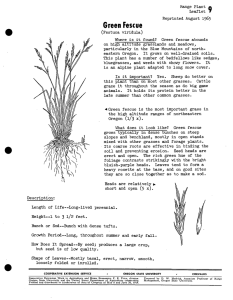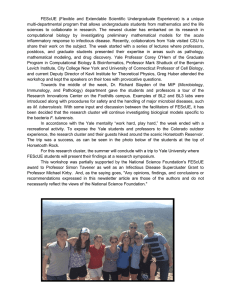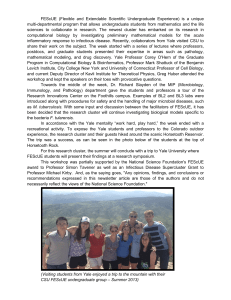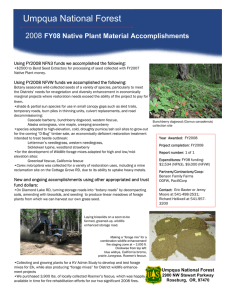Document 13273694
advertisement
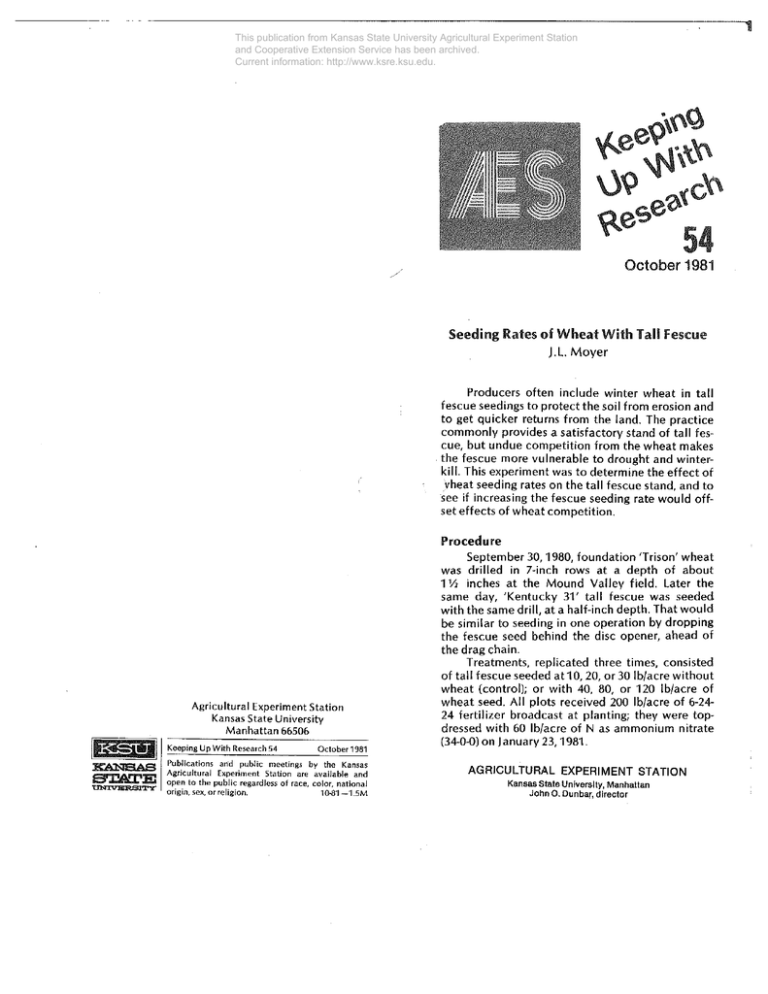
This publication from Kansas State University Agricultural Experiment Station and Cooperative Extension Service has been archived. Current information: http://www.ksre.ksu.edu. Seeding Rates of Wheat With Tall Fescue J.L. Moyer Producers often include winter wheat in tall fescue seedings to protect the soil from erosion and to get quicker returns from the land. The practice commonly provides a satisfactory stand of tall fescue, but undue competition from the wheat makes the fescue more vulnerable to drought and winterkill. This experiment was to determine the effect of vheat seeding rates on the tall fescue stand, and to see if increasing the fescue seeding rate would offset effects of wheat competition. Procedure Agricultural Experiment Station Kansas State University Manhattan 66506 Keeping Up With Research 54 October 1981 Publications public meetings by the Kansas Agricultural Experiment Station are available and ope n to the public regardle ss of race, color, national origin, sex, or religion. 10-81-1 .5M September 30, 1980, foundation 'Trison' wheat was drilled in 7-inch rows at a depth of about inches at the Mound Valley field. Later the same day, 'Kentucky 31' tall fescue was seeded with the same drill, at a half-inch depth. That would be similar to seeding in one operation by dropping the fescue seed behind the disc opener, ahead of the drag chain. Treatments, replicated three times, consisted of tall fescue seeded at10, 20, or 30 lb/acre without wheat (control); or with 40, 80, or 120 lb/acre of wheat seed. All plots received 200 lb/acre of 6-2424 fertilizer broadcast at planting; they were topdressed with 60 lb/acre of N as ammonium nitrate (34-0-0) on January 23, 1981. AGRICULTURAL EXPERIMENT STATION Kansas State University, Manhattan John 0. Dunbar, director This publication from Kansas State University Agricultural Experiment Station and Cooperative Extension Service has been archived. Current information: http://www.ksre.ksu.edu. Plots with wheat were harvested June 26, 1981, to determine wheat grain yield and moisture content. All plots were clipped 6 inches high june 29, a nd fescue stands were rated on a scale of 0-5 (where 5 was a solid fescue stand with no gaps of more than a few inches in a row and 0 was practically no fescue in the plot). A rating of 3 was a "fair" stand, averaging three or tour fescue plants per foot of drill row. Results and Discussion The fall of 1980 at Mound Valley did not provide moisture for early fescue or wheat germination. Wheat began the winter without much tillering, and tall fescue seedlings were small. The winter was relatively mild a nd dry, resulting in good survival of wheat and fescue seedlings; but the dry spri ng of 1981 caused drought stress by early April. Showers in late April e nabled wheat to recover to produce a yield o f nearly 50 bu/acre. Tall fescue stands were affected dramatically by the wheat-seeding rate (Table 1 ). When wheat had been seeded at the 80-lb and 120-lb rates, fescue stands we re poor; but when at the 40-lb rate, fescue stands were almost as good as when fescue was seeded alone. No differences were found in tal' fescue stands among fescue seeding rates of 10, 20, and 30 lb/acre, nor were there inte ractions between seeding rates of wheat a nd fescue. Table 1. Tall fescue stand ratings (0-5) and wheat grain production (bu/acre at 12.5% moisture, 60 lb!bu test weight) in june, 1981, as affected by several seeding rates of w heat the previous fall. (Averages of three fescue seeding rates and three replications are shown.) Wheat seed ing rate, lb/acre Fescue stand rating* Wheat production, bu/acre 0 40 80 120 5.0 4.1 1 .2 0.9 1.1 49 LSD 42 47 NS • 5 = solid fescue stand; 0 = practically no fescue in plot. Wheat performance was little affected by seeding rate (Table 1 ). The 40-lb seeding rate appeared to yield less grain than did highe r seeding rates, but differences were not statistically significant at the 5% level of probability. These data suggest that wheat can be seeded with tall fescue with little effect on the tall fescue stand. They a lso show, however, t hat seeding rate of the wheat can be a c ritical factor in establishing fescue. The 40-lb wheat seeding rate is considered below optimum for wheat production, but studies have shown that a 60-lb rate is adequate for top yields under most conditions. Tall fescue seedlings might also be expected to tolerate competitive pressure from wheat better when moisture is more nearly norma l, so seeding between 40 and 60 lb of wheat should give near-maximum wheat production while a llowing the establishment of a good fescue stand. The seeding rate of fescue was less c ritic.al, so one should use the rate recommended for fescue alone, about 15 lb/acre, when seeding fescue with wheat. Conclusion Wheat can be produced while establish ing a tall fescue stand. We found that seed ing wheat at BO lb/a cre reduced the fescue stand with little increase in wheat production, whereas seeding at the 40-lb rate pe rmitted a good fescue stand. No differe nce in fescue stands was found among fescue rates of 10, 20, or 30 lb/acre.
